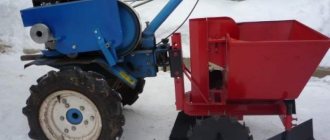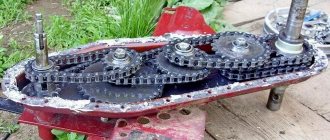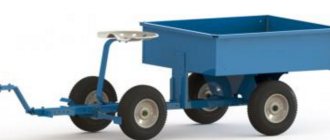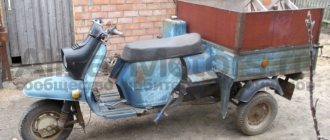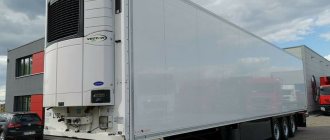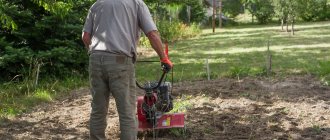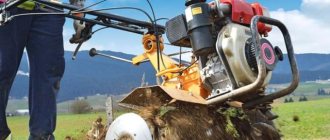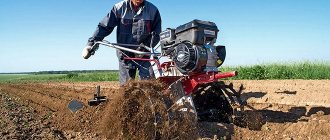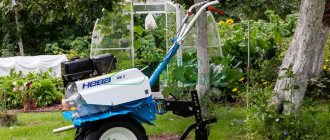The walk-behind tractor performs many useful functions on the farm. With it you can easily cultivate plots of land and perform other work. It is easy to transport to the work site. If done correctly, it will last a long time. If you are the happy owner of this useful device and its proper transportation is important to you, this article is for you.
Category on driver's license
The vast majority of car owners in our country have a category B driver’s license, which allows them to drive vehicles with a gross weight not exceeding 3.5 tons. The Federal Law “On Road Safety” (Article 25) allows a driver with category B to drive category B vehicles with a trailer in two cases:
- the maximum trailer weight does not exceed 750 kg;
- the maximum mass of the trailer exceeds 750 kg, but does not exceed the unladen mass of the vehicle, provided that the total permissible maximum mass of such combination does not exceed 3500 kg.
The unladen weight of the vehicle, as well as the permitted maximum weight, is usually indicated on the vehicle registration certificate. If you do the math, you can take away not so much. For example, a pickup truck, SUV or crossover weighing 1,700 kg can carry a small passenger car weighing about 1,100 kg on a 600-kg trailer.
The weight of an ATV, like a snowmobile, rarely exceeds half a ton. Motorcycles and walk-behind tractors are even lighter; a small boat is rarely heavier than 450 kg. For such conditions, it is important to choose a trailer with sufficient carrying capacity, and the tractor can be almost any car larger than a Matiz.
If you are going to carry something larger, then you need to think about getting category BE or CE on your driver’s license.
Practical recommendations
If the power of the equipment does not exceed 5 hp. s., the optimal dimensions of the trailer in length and width will be 1.5 and 1 m. When the parameters of the body are calculated, pieces of the corrugated pipe are cut to the required length and a frame is welded from them. The design is quite rigid, so there is no need to install reinforcing elements in the corners. In order for the seam to be smooth and of high quality along its entire length, you should work on a flat surface, preferably using electric arc welding.
Body assembly and painting
The sides of the trailer are framed with a 25-30 mm profile. Sheathing is assembled from sheet metal, which is then attached to the corrugated pipe with threaded connections. The metal for the body must be free of rust. If there is corrosion, it is removed mechanically, and then the surface is coated with a priming rust converter. The body is fitted to the frame. If all dimensions match, perform a test assembly. Then they disassemble, set the body aside, and cover the frame with oil paint. It is necessary that there are no unpainted elements left anywhere.
Helpful advice : if possible, it is better to use a polymer-based dye. The primer should not be neglected in this case either, because adhesion is better on the treated surface. Powder dyes are more resistant to abrasion, and surfaces coated with conventional oil-based compounds need to be renewed at the beginning and end of the season.
The body flooring is also coated with paint, after which it is installed in its place. Fix the joints with fasteners, then paint the protruding parts of the bolts so that corrosion does not appear in these places. If the dried paint has come off in some places during installation, these areas are touched up. A drawbar is made from the thickest pipe.
Cargo documents
in established cases, permission to carry out activities for the transportation of passengers and luggage by passenger taxi, waybill, license card and documents for the transported cargo.
So, if you come across a corrosive traffic police officer, he may begin to demand documents for the cargo. And such a desire can arise not only at the sight of a Christmas tree before the New Year, but also with any objects in a fair amount. Several boxes of alcoholic beverages, a full truck of firewood, and, of course, equipment. Naturally, new, shiny, packaged devices are of greater interest. It is unlikely that anyone will be interested in an old-looking tractor with grease stains and stuck clods of earth, or a dirty dirt bike that is not intended for public roads.
The key word is “relationship.” When transporting personal belongings, you do not have any relationship. Your only task is to convince the inspector that the cargo belongs to you or family members present in the car. Then the legal concept of cargo transportation does not arise.
Although it is still better to have documents for the transported equipment. For the walk-behind tractor - a receipt, a warranty card. For a boat with a motor - ship ticket. For a motorcycle - STS. For the quadric there is a certificate of registration from Gostekhnadzor.
What to carry?
The most convenient way to transport any of the devices mentioned is to place it in the back of a pickup truck or minivan. This way you are practically unlimited in speed, while with a trailer on the highway - up to 90 km/h and on a regular road - up to 70 km/h.
Mount for a walk-behind tractor in a car trailer. Transporting a walk-behind tractor in a trailer
Without a trailer, aerodynamics are better and, accordingly, fuel consumption is lower. And the cross-country ability is higher, which is important in the “last mile” before the target. It is more convenient to secure cargo in the back of a pickup truck, since there are usually mounting eyes there. Some trailers, for example, do not have them. But if you can’t do without a trailer, pay attention to the following two points.
Types of towbars for walk-behind tractors
Single-axle garden equipment usually has hitch units at the front and rear. What is attached directly to the wheelset is usually called attachments, and everything that is attached through a special hitch is called towed devices. The latter are divided into highly specialized and multifunctional.
Transporting a walk-behind tractor on a car trailer.
The first type is a harrow, which the walk-behind tractor drags behind itself, or a potato planter. There are also specialized devices, for example, a ski module for deep snow; a two-seater drag sled on long runners is attached to the rear as a trailer. The second type is landing and steering devices or, more simply put, adapters. They are absolutely universal, that is, they are just intermediate links between the walk-behind tractor and devices that are designed for cultivating the land.
In other words, you can attach a harrow directly to a biaxial vehicle and walk alongside it, turning the steering wheel to the right or left, or, after installing a landing module, attach it behind it. In this case, the operator is provided with more comfortable control of the walk-behind tractor; in addition, the adapter allows you to hang 2 devices at once, in front and behind. The adapter usually looks like a longitudinal beam with its own wheelbase, a seat is installed on top, and there is a platform for the feet.
It is worth mentioning trolley-type trailers separately, since, on the one hand, they are highly specialized and are intended only for transporting goods, but they can transport anything. The trailer is a variant of the adapter, but its wheel axle is significantly moved back and lengthened, since it is on top of it that a rather capacious body, rigidly reinforced or dump-type, is usually installed. There are quite a few modifications that differ in the material from which the body is made, wheelbase and maximum load.
How to make a cart bottom
The most unreliable, but fastest way to make a bottom for a cart is to carry out the work using a cut wooden board. However, if you want to get a strong and durable device, then the bottom material should be metal sheets with a thickness of at least 2 millimeters. A cart with such a bottom will last for many years without rotting or requiring frequent repairs.
When all intermediate steps and components have been completed, you can begin assembling the unit. To do this, it is better to follow a certain sequence:
- The main pipe is welded to an additional one, which serves as an axle for the cart. You can also use any ready-made vehicle wheel assembly.
- The walk-behind tractor hitch is attached to the opposite side of the pipe. You need to make sure that the welding is strong so that the welded parts do not separate at the most critical moment.
- The hubs are firmly secured to the ends of the main axle, best also using welding.
- Next, you should install the wheels, secure them with nuts and bolts, tighten them securely and tightly so as not to lose the disks along the way.
- Next, a parking device is attached to the beginning of the pipe so that the trailer occupies a horizontal position when it is uncoupled from the motor vehicle and is standing idle.
- The last step is to attach the body and wings.
After completing all the steps, the cart is almost ready for use. You just need to attach a chair and footrests for the person who will operate the unit. For this, a steering wheel and corresponding levers are used. The convenience and comfort of the driver can be improved by attaching a backrest to the seat and upholstering it with soft material, or simply placing a pillow under the back.
Having familiarized yourself with how to make a cart for a walk-behind tractor, you can easily and simply, following the instructions outlined, make the device with your own hands, significantly reducing material costs, and get an excellent assistant when working in the garden and personal plot, which will allow you not only to save strength, but and reduce time. You can, without hesitation, transport the harvested crop, various fertilizers, and construction materials, using not a car, but a walk-behind tractor.
A trolley for a walk-behind tractor is a towed equipment for universal agricultural motor vehicles for transporting goods on personal plots and land plots. With the help of such a mechanism, garbage, animal feed, building materials, fertilizer, grain, and equipment are transported.
The trailer and adapter for the walk-behind tractor are types of homemade products made by skilled mechanics. The adapter is a longitudinal beam with its own chassis, driver's seat and footrest. This module makes it possible to cultivate the soil in a sitting position, as well as attach 2 equipment at once - in front and behind.
A trolley is a type of adapter with a difference in the design of the chassis.
A purchased cart for a walk-behind tractor is expensive. To save money, craftsmen make it themselves, design design drawings, and select the necessary materials. The process of creating such a useful vehicle does not take much time and is not difficult. Even a beginner with at least a little knowledge of technology can handle it.
A brief overview will help you understand the question of how to make a trolley for a walk-behind tractor yourself with good performance characteristics.
Using an adapter to expand capabilities
The landing and steering device allows you to work on the land in a more intensive mode. If walking behind a walk-behind tractor is limited, as a rule, by the operator’s movement speed and endurance (high speed will very quickly lead to fatigue), then the adapter solves this problem. That is, you can slightly increase the speed of plowing or hilling if the weight of the plow or the speed of the cutter allows it.
The same applies to removing snow or leaves from paths using a rotating brush. But with a blade for snowdrifts it will be more difficult, since you will often need to reverse, which is more convenient to do while standing, simply rolling the walk-behind tractor back, than sitting and switching the direction of movement.
But this applies to the front attachments. But the rear one, which clings to the adapter, depends solely on the landing and steering device itself. There are actually adapter modules and frame modules, the difference between them is quite significant. The first ones are almost always made on the basis of a rod equipped with a driven axis under the operator’s seat. There is also a footrest on the longitudinal metal beam, where there is often a pedal for connecting the walk-behind tractor with a cable. Budget models do not have such a pedal, and you have to shift by leaning forward towards the body, which is not very convenient.
Frame types of landing and steering devices look completely different; they are ready-made kits for converting single-axle equipment into full-fledged mini-tractors. Essentially, the metal frame is installed so that the walk-behind tractor is in the center (under the driver's seat) or in the rear. In this case, the adapter is attached rigidly, and the steering is switched to the front axle, driven by simple rods. Of course, the steering column of the walk-behind tractor is dismantled as unnecessary. In some cases, the frame provides for the installation of a single-axle garden device in the front, which somewhat simplifies the assembly of the mini-tractor.
The advantages of adapters with a movable hitch are obvious: on the basis of a walk-behind tractor, more powerful and comfortable garden equipment is very quickly assembled, which can also be used as a vehicle. In addition, the load strictly calculated for them is distributed on the axles: the front wheels bear the weight of the engine, and the rear wheels bear the weight of the operator. However, a plus sometimes turns into a minus, in particular, due to the movable coupling, the overall stability of the equipment deteriorates. Frame landing and steering devices do not have this drawback due to the rigid connection with the walk-behind tractor. In addition, their advantage is that the weight of the entire structure, and not just the adapter, is transferred to the plow. The disadvantage is the difficulty of remaking the equipment.
Self-production of a trailer for a walk-behind tractor
The design of the cargo adapter for the walk-behind tractor cannot be called extremely complex. If you have an electric welder, an angle grinder and a drill, almost every owner of a hand tractor can make a trailer for a walk-behind tractor with their own hands.
The main structural elements, the manufacture of which will require a drawing or detailed diagram, are the frame, carrier and body.
1 — mounting bracket for walk-behind tractor; 2 – rotary console, 3 – carrier; 4 – footrest; 5 — seat (20mm board); 6 – trailer frame; 7 — body side made of 25 mm board; 8 — frame support beam (block 50×50mm); 9 – fixing bolt of the M8 hinge; 10 – rear hinge unit; 11 - wheel
Studying the design of the trailer for the walk-behind tractor shown in the figure, you will notice that the driver is connected through the rotary unit and the console to the trailer module of the walk-behind tractor. The second end of the carrier is inserted into the central tube of the frame.
The “pipe-in-pipe” design forms a kind of long hinge. It allows the wheels of the trailer to change their position independently of the wheels of the walk-behind tractor while overcoming holes and bumps. This solution avoids deformation of the trailer structure.
Rice. 1
1 - swivel unit; 2 – “drawbar” (round pipe 60 mm); 3 – footrest frame (angle 25 mm); 4 – stiffeners
The articulated coupling of the walk-behind tractor with the trailer is made using a console - a steel axle. It stands in the rotating block of the carrier on bearings. A flange is welded to the top of the console, with which it is attached to the hitch of the walk-behind tractor.
To strengthen the junction of the drawbar with the body of the rotary unit, you need to use 4 stiffening ribs from a steel strip 4 mm thick.
When making a homemade trailer for a walk-behind tractor, its frame is welded using several types of rolled metal: angle, rectangular and round pipes. The supporting frame must be strong and rigid so that when moving with a full load, its structural elements do not deform.
Fig.2
1 - brace (corner 20 x 20); 2 — seat frame (corner 20×20); 3 — seat posts (corner 40×40); 4.5 — front struts (pipe 40×20); 6 — body frame strapping (angle 40×40); 7, 8 – wheel axle stands (angle 32×32); 9.10 — rear struts (pipe 40x20); 11 — reinforcing cross member (angle 40×40), 12 — central pipe 58×4; 13 - axle (30 mm rod), 14 - gusset (4 mm sheet).
Rice. 3
To fix the carrier pipe in the central pipe of the frame, drill a hole through it and insert a bolt with a lock nut and a pin. In this case, you need to cut a long “window” in the central pipe.
In it, the fixing bolt passing through the carrier pipe will be able to move around the axis of the trailer without moving in the longitudinal direction. This is the final operation necessary for the reliable operation of the “pipe-in-pipe” joint, which we described above.
Node 1
To make a wheel axle, you need to take a high-quality steel rod with a diameter of 30 mm. It is connected to the central pipe of the frame, the platform frame from the corner and the struts by electric welding.
The fixed body can be made from 25 mm boards or its sides can be made from a steel sheet 1.5 mm thick, welded onto vertical posts from a 40x40 mm corner. If there is a need to open the sides, then several hinges need to be welded to the frame, to which the side frame will be attached. It is necessary to weld bolts to the corners of the frame, which will fix the sides in the transport position.
In a properly balanced trailer for a walk-behind tractor, the center of gravity of the load is located closer to the front side and does not extend beyond the axis of rotation of the wheels. This requirement must be taken into account when drawing up a drawing of a homemade structure.
You can use passenger car wheels as trailer wheels by purchasing them complete with hubs. Before installing the wheels on the axle, you need to carefully machine its seats to the inner diameter of the wheel hub bearings and equip them with a lock nut with a locking cotter pin.
Useful video on the topic:
Types and features of designs
Trailers have different load capacities, and this is one of the criteria used to classify them. Most often, at home there is no need to use devices with a high load capacity. In addition, all trailers for walk-behind tractors can be divided into groups according to their design:
- Solid - have the simplest design, in which the bottom and walls are connected motionlessly.
- With folding sides - great for transporting large cargo.
- Tipper - convenient during unloading operations and allows you to increase their productivity.
When planning to purchase a trailer or make a cart for a walk-behind tractor with your own hands, it is important to take into account some design features.
If everything is quite simple with solid towbars, then in the case of other types it is necessary to do this. Particular attention should be paid to the following factors:
READ How much oil to pour into a walk-behind tractor
Frame covering
This is one of the easiest steps in creating a tow hitch. However, some nuances are present and must be taken into account. To carry out work on framing the frame, it is worth choosing those materials that cannot increase the cost of the tow hitch:
- Wood is the most affordable material, but not the most practical due to its low resistance to moisture. In order for the boards to last as long as possible, it is imperative to treat them with special compounds and constantly monitor the integrity of the coating.
- Plastic lacks the main drawback of wood, but at the same time has poor resistance to mechanical damage.
- Metal sheets must first be treated with anti-corrosion compounds and are the most durable, but also quite expensive material.
First you need to sheathe the bottom (floor) of the trailer, and then work on its sides.
Build process
If you are planning to make a trailer for a mini tractor at home, you will need the following tools and materials:
- steel sheets;
- plywood;
- steel channel;
- aluminum tubes;
- chassis;
- electrical equipment;
- wheels;
- metalworking tools;
- welding machine.
At the very beginning, you need to weld a frame that acts as a supporting frame. It can be made from round pipes with a diameter of more than 40 cm. All fasteners must also be welded.
Now you can move on to making the wheelbase, where you should use a steel rod as an axle. It is bolted firmly to the frame, and side rails and corner supports can also be used. A self-made trailer for a walk-behind tractor can serve you for many years for transporting various things.
Dump trucks are capable of not only transporting household appliances and materials, but also unloading them with ease. For this purpose, the design is equipped with a special body, which has a rectangular shape. The unloading mechanism is usually located at the rear.
In addition, experts advise making your device from the most common materials that are always at hand. You can make a trailer with your own hands from an old Moskvich car, capable of holding a load of up to 750 kg. It is inferior to a product made from a motor scooter with a load capacity of up to 500 kg. The maximum weight that a trailer for a walk-behind tractor can lift with your own hands reaches one ton.
The best body for a dump truck is made from boards of any type of wood
It is important to choose all the necessary sizes. The height of the body is selected depending on what exactly you want to transport
The boards must be thoroughly dried and secured tightly with metal corners. This guarantees a strong connection and resistance to heavy loads.
The central wheels are located at the bottom. They are spaced (one from the other) at the maximum possible distance to distribute gravity. They provide complete security and should be as reliable as possible. To do this, you can take the main part from the articulated drawbar, which is inserted into the tubular body of this moving part. This part has a fuse on top that provides an additional level of protection against accidental disconnections.
Carefully approach the design of the unit, since this part has a high load from vibration and friction.
After all the parts are prepared, they need to be assembled into one device. This cannot be done by one person, so it is best to work in pairs. Be careful before each assembly step. Check the quality of fastening of the components, the reliability of the hinges and the tightness of the bolts several times. When the device is ready, it needs to be run in first without a load. This process is necessary for the parts to get used to each other.
Specialized trailers for single-axle garden equipment
Let's take a closer look at the special devices attached via a hitch behind the walk-behind tractor. First of all, these are ski modules for the winter season. Of course, there is no need to plow at this time, and the rear hitch, as a rule, is not used, but such a drag, especially with a seat, allows you to turn a walk-behind tractor into a winter vehicle.
The new capabilities will be especially appreciated with a rotary snow blower or blade installed in front - snow removal will take place without tiring walking through loose snow. A particularly good solution would be to combine a ski module with a tracked attachment, which will significantly increase cross-country ability and turn single-axle equipment into a motor sleigh.
The second option is a trailed tank with a capacity of about 300 liters, which can be used simply to transport water to the site or for watering distant plots where irrigation ditches are not installed. As a rule, this is also a cart, but with a platform on which a large container is installed. Less common are models in which the tank is fixed with special fasteners, that is, it is removable. This trailer for a walk-behind tractor is equipped with a small seat for the operator. On the platform you can install a motor pump and a transverse pipe with nozzles for forced irrigation by spraying water over a wide band.
Additional drawings of a homemade trailer
Additional materials with detailed descriptions and diagrams of individual components of the trailer hitch for a walk-behind tractor will help you decide on the design and give an idea of the assembly stages.
General view drawing
1 — hinge body; 2 – drawbar (pipe 43x43x5); 3 — footrest (corrugated sheet (steel) s5); 4 — frame (pipe 43x26x5); 5 — trunk (seat lid is not shown); 6 — side (steel sheet s1.5); 7 — handrail (pipe 21×1.5); 8 — stand (pipe 18×1.5, 8 pcs.); 9 — bottom (steel sheet s1.5); 10 — axle shaft housing (2 pcs.); 11 — scarf (sheet (steel) s5, 6 pcs.); 12 — bead liner (wire 3mm in diameter); 13 — back wall of the box (sheet (steel) s1.5).
Characteristics
Trailer , which is very often called a trolley, is used for transporting goods, and also in combination with a walk-behind tractor as a vehicle. The speed of movement of a trolley coupled to a walk-behind tractor is 10 kilometers per hour. This device not only allows you to transport cargo over difficult terrain, but also enhances the stability of the walk-behind tractor itself. In general, the standard dimensions of cart bodies are as follows: 1.5 m long, 1 m and 15 cm wide, as well as a height of 27-28 cm. With great specificity, the main characteristics of trailers can be considered using the example of Neva walk-behind tractors, for which there is four main device models.
- This can be a single-axle dump truck capable of transporting up to 250 kilograms of cargo. The trailer weighs 56 kilograms, its length is 110 centimeters, and its width is 90 centimeters. The height of the sides of this cart reaches 35 centimeters.
- There is a two-axle chassis trolley that can carry 500 kilograms of cargo. She herself weighs 40 kilograms. The height of the sides of the cart is the same as that of a single-axle cart, as well as all other parameters.
- For the Neva, a TMP trolley is suitable, which can carry 250 kilograms. The structure itself weighs the most - as much as 150 kilograms. The length of the cart is 133 centimeters, the width is 110 centimeters, and the sides are thirty centimeters high.
- There is a TMP-M trolley. She herself weighs 85 kilograms, and her carrying capacity is 150 kilograms. The sides in this case reach a height of 25 centimeters, a length of 140 centimeters, and a width of 82.5 centimeters.
Despite the 4 models available, in the case of the Neva, it will be possible to attach other trolleys to the walk-behind tractor if you first select a universal hitch.
Self-production of a hitch for a walk-behind tractor
A special hitch is used to connect the trailer to the walk-behind tractor. Its dimensions and design may vary depending on the walk-behind tractor model. In general, such a system should ensure structural stability and facilitate the controllability of the walk-behind tractor.
PHOTO: stroy-podskazka.ru The configuration of a do-it-yourself walk-behind tractor hitch may differ
Hitch drawings for a do-it-yourself walk-behind tractor
To make a hitch for a walk-behind tractor with your own hands, you need to develop a detailed drawing. It will contain all the necessary information about the main elements and their sizes. When developing the design, the features of the walk-behind tractor itself are taken into account. We invite you to familiarize yourself with the drawings of possible options:
PHOTO: referatdb.ru
PHOTO: referatdb.ru
PHOTO: f.6324780.xyz
How to make a hitch for a walk-behind tractor: algorithm of actions and video instructions
Drawbar - a system of welded pipes connected to the side member of the trailer. A trailer hitch for the walk-behind tractor is mounted at the connection point. Its installation should be relatively simple. At the same time, the connection should be strong, reliable, allowing easy rotation of the trolley with the walk-behind tractor.
Having studied photos, videos, and developed drawings with dimensions for making a trailer with your own hands, you can begin assembling the structure. The work is performed in the following sequence:
- at the junction of the drawbar pipes, we weld a piece of pipe with a diameter of 40 mm and a length of 10 cm;
- we press two bearings inside the pipe;
- Install a washer on the pipe from the trailer side. It will be used to accommodate the threaded axle from the tow hitch;
- We form a hitch from a square pipe. To do this, a through hole is drilled, the diameter of which is equal to the transverse dimensions of the fixing pin;
- We strengthen the square pipe with a sheet of metal. The edges of the pipes are bent.
We invite you to watch a video that tells you how to make your own trailer hitch for the Neva walk-behind tractor:
Watch this video on YouTube
Watch this video on YouTube
Design Features
Trailers usually consist of a specific set of parts, which include the body, fenders, brakes, seats, tongue and wheels with a hub. The most suitable bodies are made of galvanized steel, which will not deteriorate in adverse weather conditions. It is also important to have folding sides to load and remove transported goods. In principle, the bodies are quite voluminous, so to transport 500 kilograms, a structure whose width does not exceed 1.2 meters will be sufficient. It is important to understand that the characteristics of the body will determine how much cargo and in what quantity can be transported.
The optimal wheel sizes are 4 by 10 inches - these will be able to navigate difficult terrain even with heavy loads. In the case where the trailer is to be actively used for agricultural work, it is necessary to select reinforced wheels that can move even on sticky soil. The drawbar is a part thanks to which the trailer is attached to the walk-behind tractor itself. It is important to mention that the tow bar does not fit every trailer, so when purchasing it is important to consult with a specialist or initially choose a universal model.
Trailer fenders are installed above the wheels and protect them from stones and large clods of dirt. The presence of a seat with a box allows you to store any items in the trailer on a permanent basis. As for brakes, their presence in the cart is mandatory when it is planned to transport a large amount of heavy cargo. This detail will provide not only convenience, but also safety of transportation for the driver and others. Typically, a trailer requires two types of brakes: a standing hand brake and a band brake. Unloading, as a rule, occurs when using the first type.
READ How to Assemble a Milling Cutter for a Centaur Motoblock
It should be noted that an adapter for a walk-behind tractor is often used as a trailer, to which the trolley is already attached. With its help, you can perform agricultural work, including transporting loads, without leaving the seat.
Materials and tools
To create a trailer on a walk-behind tractor with your own hands, you may need the following tools:
- welder;
- "Bulgarian";
- lathe;
- drill;
- spanners;
- hammer or sledgehammer;
- ruler or measuring tape;
- screwdriver;
- fasteners (bolts, nuts, etc.);
- sandpaper;
- file;
- electric saw.
Depending on what materials will be used for the future trailer, the set of tools may vary slightly. However, most of them are indispensable when creating additional equipment for a walk-behind tractor.
First of all, when choosing materials, it is worth considering what the trailer body will be made of. The cheapest material for it is wood. For example, you can use boards about 0.2 cm thick. It is worth considering that they need to be reinforced at the corners with metal overlays. It is convenient to fasten such a body using support frames made of timber and bolts.
Wooden trailers are best suited for transporting bagged goods. In this case, the sides of such a device will not fold down. It is advisable, before finally choosing what the body will be made of, to calculate the load, and also estimate what kind of cargo will be transported in it.
You can also make a body from metal sheets, the thickness of which is from 1 mm. This material is the most versatile. It is also quite easy to make it durable with the help of primer and painting.
Corrugated sheeting is also suitable for making a trailer. However, it must be taken into account that this material requires additional stiffening ribs.
To make a wheel axle, you can use a steel rod approximately one meter long. This length will allow you to place the wheels on your homemade trailer most correctly. A VAZ-2109 beam is also suitable as an axis. A good option would be to use the entire rear axle, including the wheels.
Wheels from any equipment can be used as wheels. The only condition is that their size matches the technology. For example, wheels from a cradle or Zhiguli are a good option for a trailer. You can also use wheels from garden equipment with a radius of 40.6-45.7 cm. Wheels from the Ant scooter would be a good option.
Transportation of a walk-behind tractor and a walk-behind tractor
Many farmers and land owners use walk-behind tractors and motor-blocks on their farms. This multifunctional equipment allows you to perform a wide variety of agricultural work. A special feature of the operation of such equipment is the prohibition of movement on public roads.
Loading a walk-behind tractor onto a trailer. Transportation.
Motoblocks and motor tractors are not registered with road services. In addition, the self-propelled qualities of a walk-behind tractor and a walk-behind tractor are low; they are unsuitable for traveling long distances. There is a need for a set of activities that are commonly called “transportation of a walk-behind tractor.”
Transportation of a walk-behind tractor or mini tractor is necessary for:
- moving the walk-behind tractor to another area,
- installing a motor tractor in a garage for winter storage,
- delivery to a service workshop for repair, etc.
Safe transportation of a walk-behind tractor or a walk-behind tractor involves following a few simple recommendations:
- For transportation, you can use the cargo compartment of a van, the back of a pickup truck, a passenger trailer , or a carriage.
- When choosing a method for transporting a walk-behind tractor, take into account the dimensions of the walk-behind tractor and the tractor: they should not protrude beyond the dimensions of the vehicle more than allowed by the transport service.
- a trailer for transportation , secure it to the vehicle before loading to prevent it from tipping over.
- For loading you need to use special ramps. installed correctly and securely so that they do not slip out from under the equipment during loading. If you are driving a vehicle under your own power, drive slowly and carefully. All this must also be done when unloading equipment.
- After loading the equipment, secure it securely. Place the walk-behind tractor or motor-tractor in gear and build a wooden structure to secure the wheels (parking shoes) during transportation. Also, to secure the equipment, use transport belts with tightening mechanisms; they will help securely secure your walk-behind tractor or mini tractor and protect it from tipping over or moving. The belts must be fastened in the form of guy wires from the walk-behind tractor or motor-tractor to the sides of the trailer, body or carriage platform.
Following these simple recommendations will allow you to transport your walk-behind tractor efficiently and safely.
Transportation of a motor tractor and walk-behind tractor
A variety of agricultural sectors require universal and efficient technology for their needs. Both ordinary walk-behind tractors, mini-tractors and their full-size counterparts, as well as huge combine harvesters, are used. In addition to the equipment itself, farmers also use many devices (seeders, harrows, etc.).
And if individual parts or small-sized walk-behind tractors are very easy to transport, larger machines require a more responsible approach to their transportation - attach belts to the tractor, use parking shoes and other nuances. The rest of the article discusses in detail the main recommendations for transporting agricultural machinery.
Transportation Features
Transportation of agricultural machinery is seasonal: most often it occurs before the start of sowing (in conditions when the snow melts), and then at the end of August, before harvesting. Complications when transporting equipment during these periods are often roads washed out by rain or melted snow. In addition, motor tractors and walk-behind tractors do not have good self-propelled characteristics, because their designs are not designed and are not suitable for covering long distances.
Common cases for transporting walk-behind tractors and motorized tractors are:
- Transportation of devices to other areas (remote areas);
- Moving agricultural equipment to the garage (for winter storage);
- Delivery to service points for repair.
Transportation in a car
The unit is delivered in a vertical position (this is stated in the instructions). During transportation, placement to the left, right or back threatens oil from the catheter initially entering along the piston walls into the combustion chamber, and then leaking through the muffler or filter not only into the car interior, but also into the fluid entering the above-piston space of the engine cylinder. The air filter will also have to be replaced with a new one.
The only possible position for transporting specialized equipment with a four-stroke engine is “standing” or tilted towards the front, where the gas tank and switch switch are installed.
If the device is equipped with a dry sump (the lubricant supply system for engine parts is supplied from a separate reservoir), transportation is possible in any position.
The walk-behind tractor has large dimensions with protruding parts. Partial disassembly of the apparatus for earthworks (removal of handles and wheels - plows) will allow it to be placed in the trunk of most brands of cars. To do this, simply fold out the rear seats.
Manipulating the disassembly of a walk-behind tractor requires technical skills and special tools. Information on this topic can be obtained on the Internet.
Useful tips
To minimize the risk of accidents or damage to your agricultural machinery, observe a few simple halts when moving your agricultural transport:
- A walk-behind tractor or a walk-behind tractor can be placed in a passenger trailer, the back of a pickup truck, the cargo compartment of vans, or use a carriage.
- After loading the walk-behind tractor or walk-behind tractor, secure them firmly. Place the agricultural machinery in gear and secure the wheels (with wooden blocks or parking shoes). For securing vehicles, transport belts with tightening mechanisms are also very suitable: this will secure it and prevent it from tipping over or moving away while the vehicle is moving. Belts on a motor tractor must be attached in the form of guy wires from agricultural machinery to the side of the body or trailer.
- If you resort to transportation using a carriage or trailer, first of all attach them to your machine before loading the motor tractor directly - this will avoid a possible rollover.
- Use only the option for moving agricultural machinery that is consistent with their size. Dimensions must not protrude beyond the trailer or body beyond the permissible limits of road services.
- When loading, ladders will come in handy; they must be installed correctly and firmly secured - this way your motorized tractor will not slip out during the loading process. When entering the device under your own power, or vice versa, when unloading, move slowly and carefully.
Take this minimum of advice into account - and your equipment will be delivered safely and without incident.
Sources:
https://tractoramtz.ru/pritsepy/kak-pritsepit-avtomobilnyj-pritsep-k-motobloku.html https://kruchkov.com.ua/ua/archive-statej/item/perevozka-motobloka-i-mototraktora https: //motokosmos.com.ua/news/perevozka_mototraktora_i_motobloka
